
The wireless intraoral camera market is a rapidly growing segment of the dental industry, driven by advancements in technology and increasing demand for efficient and convenient dental imaging solutions. Intraoral cameras are small, handheld devices that allow dentists to capture high-quality images of the inside of a patient's mouth in real-time, providing valuable visual information for diagnosis, treatment planning, and patient communication. The global wireless intraoral camera market has been steadily rising over the years, with CAGR expected to be around 10% during the forecast period of 2025 to 2033. This growth can be attributed to several factors, including the increasing adoption of digital dentistry, the growing awareness among dental professionals and patients about the benefits of intraoral cameras, and the rising demand for cosmetic dentistry and orthodontic treatments.One of the key drivers of the wireless intraoral camera market is the advancement in technology. Modern wireless intraoral cameras are equipped with high-resolution imaging sensors, powerful LED lights, and wireless connectivity, allowing dentists to capture clear and detailed images of the oral cavity. These cameras also come with user-friendly interfaces and ergonomic designs, making them easy to handle and operate, which improves the overall workflow in dental practices.

Technological Advancements
The wireless intraoral camera market is being driven by continuous technological advancements in the field of dental imaging. These advancements have led to the development of highly sophisticated intraoral cameras with advanced features such as high-resolution imaging sensors, powerful LED lights, and wireless connectivity. These technological upgrades have significantly improved the image quality, ease of use, and overall functionality of intraoral cameras, making them more effective in capturing clear and detailed images of the oral cavity.For instance, many wireless intraoral cameras now offer high-definition (HD) or even 4K resolution imaging, allowing dentists to capture images with exceptional clarity and detail. These advanced cameras also come with improved low-light performance, reducing the need for additional lighting during image capture. Furthermore, wireless connectivity enables seamless integration of intraoral cameras with other dental devices, such as computer-aided design and computer-aided manufacturing (CAD/CAM) systems, allowing for efficient and streamlined workflows in dental practices.
Increasing Demand for Efficient Dental Imaging Solutions
Another key driver of the wireless intraoral camera market is the rising demand for efficient and convenient dental imaging solutions. Traditional methods of dental imaging, such as film-based X-rays, can be time-consuming and require additional steps for image processing and interpretation. In contrast, wireless intraoral cameras offer real-time imaging capabilities, allowing dentists to quickly capture and review images during patient appointments, which saves time and enhances patient experience.Moreover, wireless intraoral cameras are portable and easy to handle, enabling dentists to capture images from different angles and areas of the oral cavity, including hard-to-reach areas. This allows for comprehensive and accurate imaging, aiding in better diagnosis, treatment planning, and patient communication. The convenience and efficiency of wireless intraoral cameras make them highly desirable in modern dental practices, driving their demand in the market.
Growing Awareness among Dental Professionals and Patients
The increasing awareness among dental professionals and patients about the benefits of intraoral cameras is also contributing to the growth of the wireless intraoral camera market. Dental professionals are increasingly recognizing the value of intraoral cameras as a powerful tool for visualizing and diagnosing oral health conditions, treatment planning, and patient communication.Intraoral cameras allow dentists to visually educate patients about their oral health conditions, treatment options, and progress, leading to better patient understanding and compliance. Patients can see the condition of their teeth and gums in real-time, which helps them understand the need for treatment and actively participate in the decision-making process. This improved communication and patient engagement lead to higher patient satisfaction and loyalty.Furthermore, intraoral cameras facilitate communication and collaboration between dentists and other dental specialists, as images can be easily shared with colleagues for consultation and referrals. This interdisciplinary approach to patient care improves treatment outcomes and enhances the overall quality of dental care.
Cost and Affordability Challenges
The wireless intraoral camera market faces challenges related to the cost and affordability of these devices. While technological advancements have led to the development of advanced intraoral cameras with improved features, such as high-resolution imaging and wireless connectivity, these advancements often come at a higher cost. The initial investment required to purchase and implement wireless intraoral cameras in dental practices can be a significant barrier, especially for small and medium-sized dental clinics or practitioners with limited budgets. Additionally, there may be ongoing costs associated with maintenance, upgrades, and training of staff on the use of these advanced devices.Evidence suggests that cost and affordability are key concerns for dental practitioners when adopting new dental technologies. A study published in the Journal of Dental Education highlighted that cost was one of the major factors influencing the adoption of intraoral cameras in dental practices, with many dentists expressing concerns about the high initial investment and ongoing costs associated with these devices (A. Szentpétery et al., 2019).
Implantology Segment Dominates the Application Market
The implantology segment generated the highest revenue in 2024 and have the highest CAGR among the application segments in the wireless intraoral camera market. The increasing demand for intraoral cameras in implantology procedures, coupled with the growing awareness about the benefits of using intraoral cameras for accurate implant placement and monitoring, is expected to drive the market growth in this segment.Intraoral cameras are used by implantologists for capturing detailed images of dental implants, bone grafting procedures, and implant-supported restorations to aid in precise placement, monitoring of healing progress, and patient education. The use of intraoral cameras in implantology allows for improved visualization of implant sites, assessment of bone quality, and accurate evaluation of implant success, leading to improved treatment outcomes. Additionally, there is a growing trend of using intraoral cameras in endodontics for capturing images of root canals, detecting fractures, and assessing the success of root canal treatments, enhancing the quality of endodontic procedures.
The wireless intraoral camera market is segmented based on end users, including dental clinics, hospitals, and others such as dental laboratories and academic institutions.
Dental Clinic Segment to Lead Revenues and Growth
The dental clinics segment generated the largest revenue in 2024 and is also expected to witness the highest CAGR during the forecast period of 2025 to 2033. This can be attributed to the increasing adoption of wireless intraoral cameras in dental clinics for various applications, such as diagnosis, treatment planning, patient education, and documentation. Intraoral cameras enable dentists to capture high-quality images of intraoral conditions, share them with patients in real-time, and engage them in the treatment process, leading to improved patient satisfaction and better treatment outcomes. Moreover, dental clinics are increasingly investing in advanced intraoral cameras with wireless connectivity and advanced imaging features for better patient care and efficient practice management.
North America Remains as the Global Leader
North America contributed to the highest revenue percent to the wireless intraoral camera market in 2024. The region has a mature dental market with a high adoption rate of advanced dental technologies, including intraoral cameras, in dental practices. Moreover, the increasing focus on cosmetic dentistry, the growing popularity of digital dentistry, and the higher disposable income of patients in North America are driving the demand for intraoral cameras for aesthetic and restorative dental procedures. This region is also expected to witness the highest CAGR during the forecast period, driven by factors such as the presence of a well-established healthcare infrastructure, increasing adoption of advanced dental technologies, and growing awareness among dental practitioners and patients about the benefits of using intraoral cameras. Additionally, the high prevalence of dental disorders, rising geriatric population, and favorable reimbursement policies for dental procedures in North America are expected to further drive the demand for wireless intraoral cameras in this region.
Product Innovation to Enhance the Market Share Among Key Competitors
The wireless intraoral camera market is highly competitive, with several key players operating in the market. These players are constantly engaged in various strategies to gain a competitive edge, expand their market share, and capitalize on the growing demand for wireless intraoral cameras in the dental industry.One of the key competitive trends in the market is the focus on product innovation and technological advancements. Leading players are investing in research and development activities to introduce advanced wireless intraoral cameras with improved features such as high-definition imaging, wireless connectivity, and ergonomic designs to enhance ease of use and patient comfort. These innovations are aimed at attracting more customers and gaining a competitive advantage in the market.Top players in the wireless intraoral camera market include DEXIS LLC, Acteon Group Ltd., Danaher Corporation, Owandy Radiology, Carestream Dental LLC, Sirona Dental Systems Inc., Dentsply Sirona, KaVo Dental, Air Techniques Inc., and Video Dental Concepts, among others. These players are actively involved in strategic initiatives such as product launches, acquisitions, partnerships, and collaborations to expand their product offerings, market presence, and customer base.One of the key strategies adopted by these players is product launches. Companies are continuously introducing new wireless intraoral cameras with advanced features and functionalities to cater to the evolving needs of dental practitioners and patients. These product launches help companies to capture a larger market share and stay ahead in the competitive landscape.The market is expected to witness further advancements in technology and increased competition among players in the coming years as the demand for wireless intraoral cameras continues to grow in the dental industry.
Historical & Forecast Period
This study report represents analysis of each segment from 2023 to 2033 considering 2024 as the base year. Compounded Annual Growth Rate (CAGR) for each of the respective segments estimated for the forecast period of 2025 to 2033.
The current report comprises of quantitative market estimations for each micro market for every geographical region and qualitative market analysis such as micro and macro environment analysis, market trends, competitive intelligence, segment analysis, porters five force model, top winning strategies, top investment markets, emerging trends and technological analysis, case studies, strategic conclusions and recommendations and other key market insights.
Research Methodology
The complete research study was conducted in three phases, namely: secondary research, primary research, and expert panel review. key data point that enables the estimation of Wireless Intraoral Camera market are as follows:
Market forecast was performed through proprietary software that analyzes various qualitative and quantitative factors. Growth rate and CAGR were estimated through intensive secondary and primary research. Data triangulation across various data points provides accuracy across various analyzed market segments in the report. Application of both top down and bottom-up approach for validation of market estimation assures logical, methodical and mathematical consistency of the quantitative data.
| ATTRIBUTE | DETAILS |
|---|---|
| Research Period | 2023-2033 |
| Base Year | 2024 |
| Forecast Period | 2025-2033 |
| Historical Year | 2023 |
| Unit | USD Million |
| Segmentation | |
Resolution Level
| |
Application
| |
End-user
| |
Technology
| |
|
Region Segment (2023-2033; US$ Million)
|
Key questions answered in this report